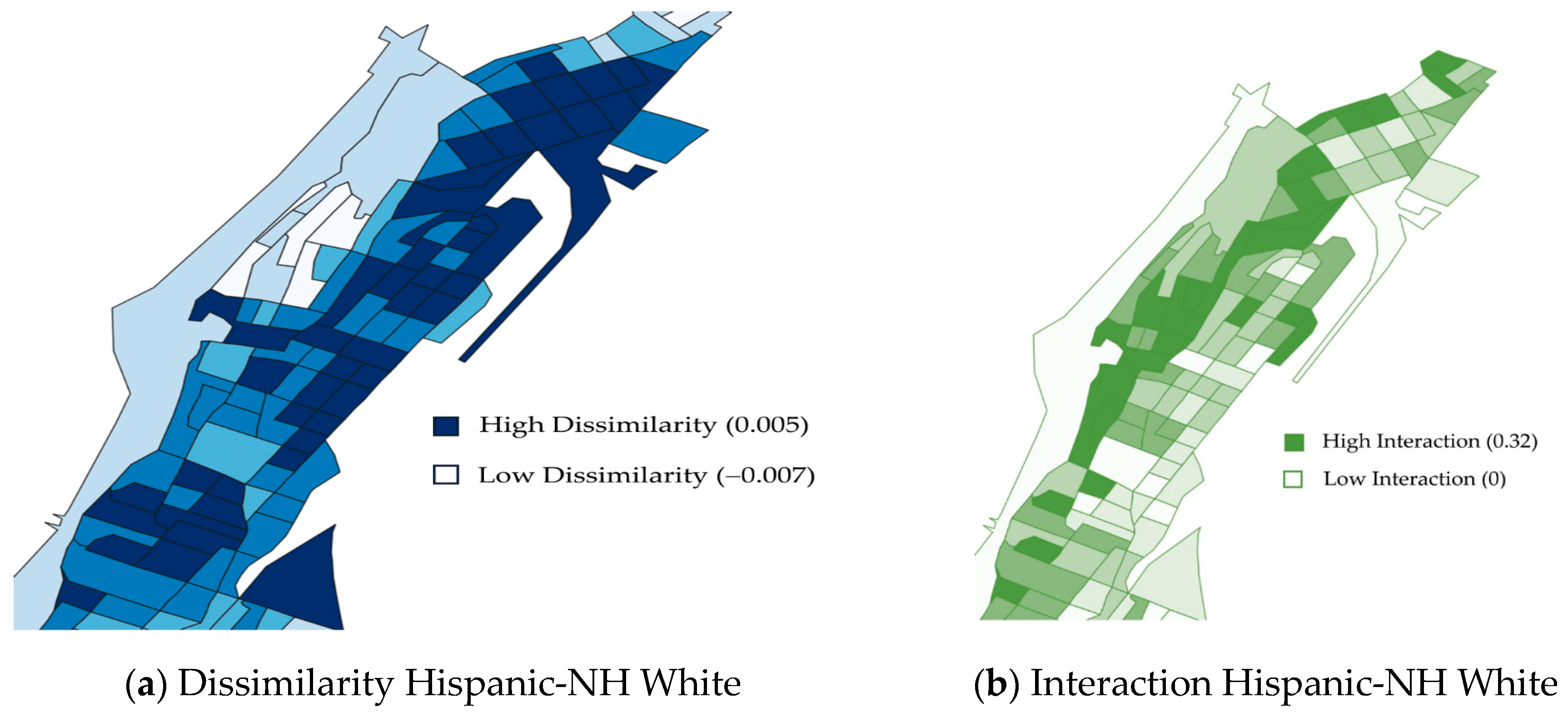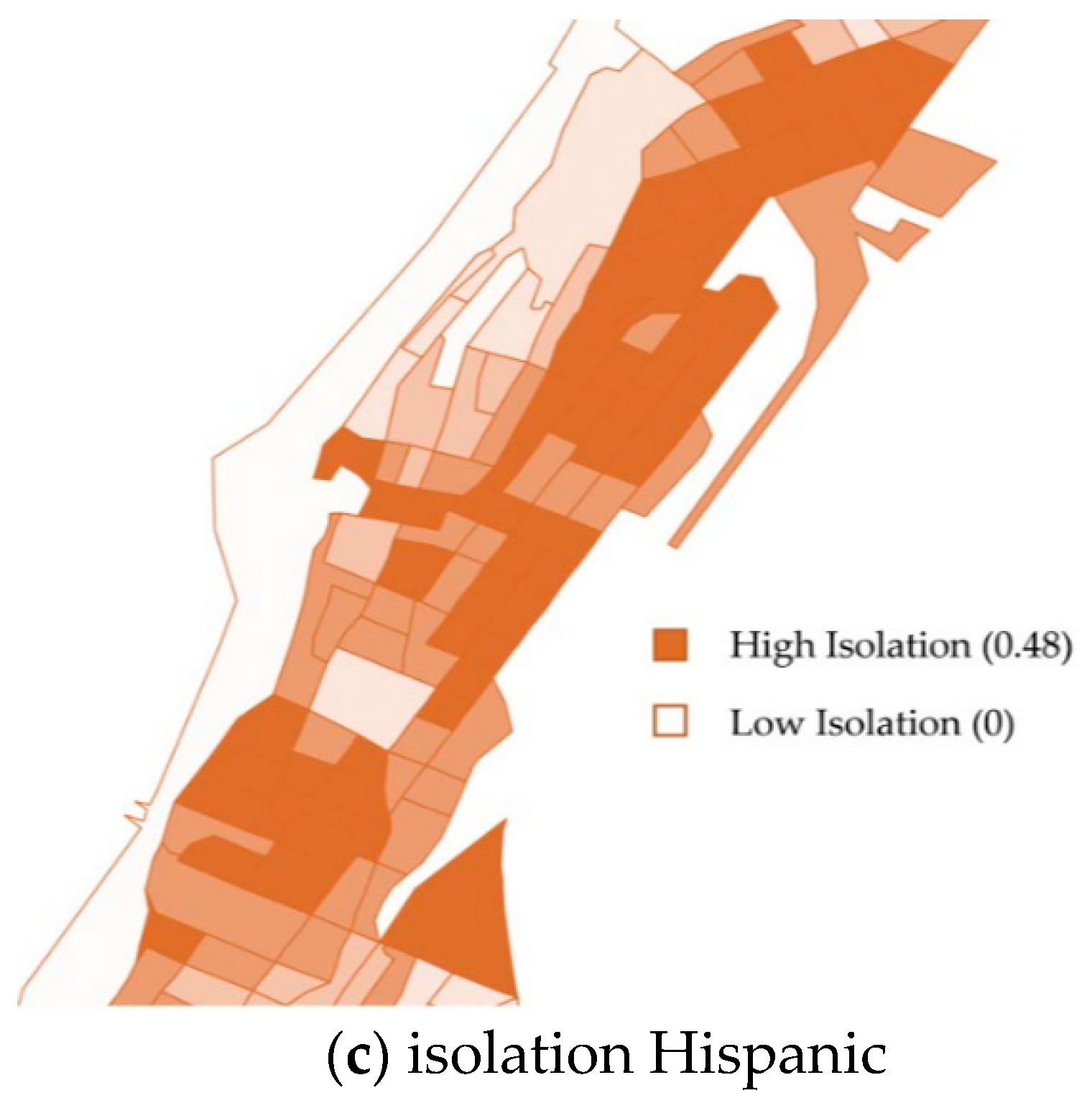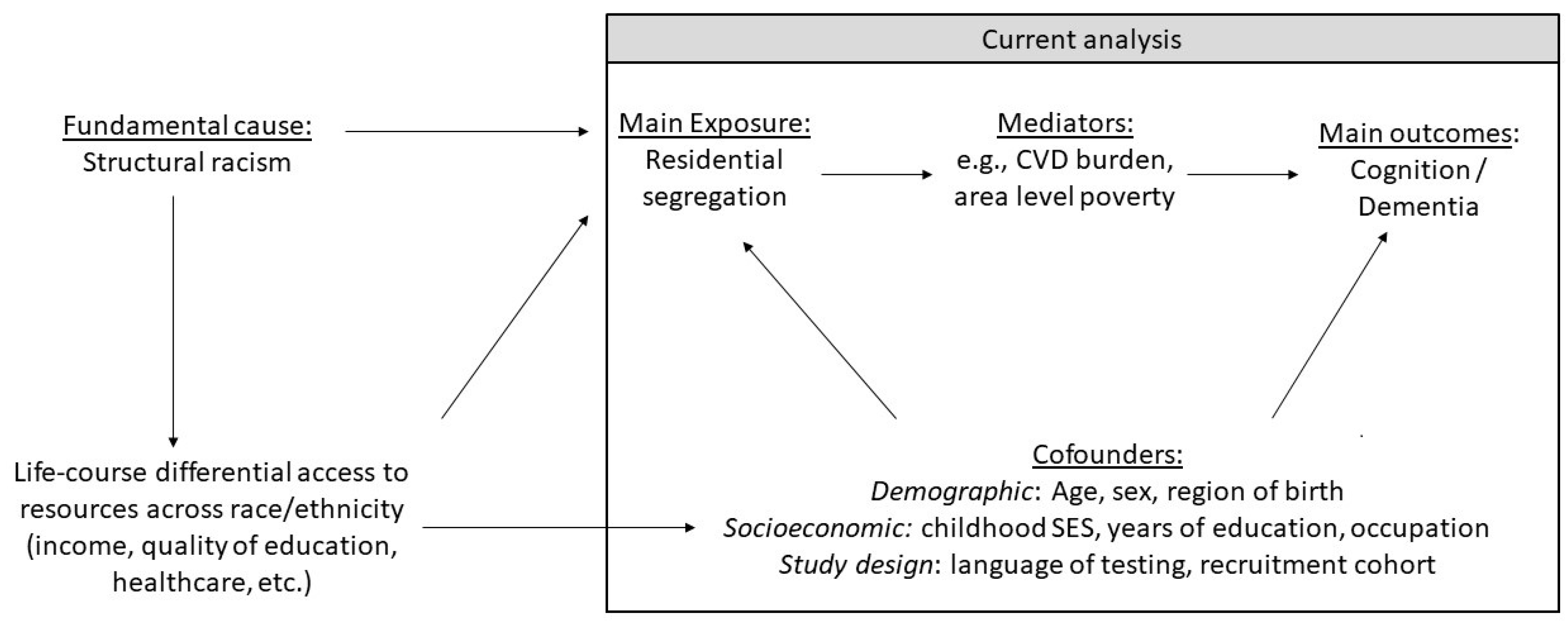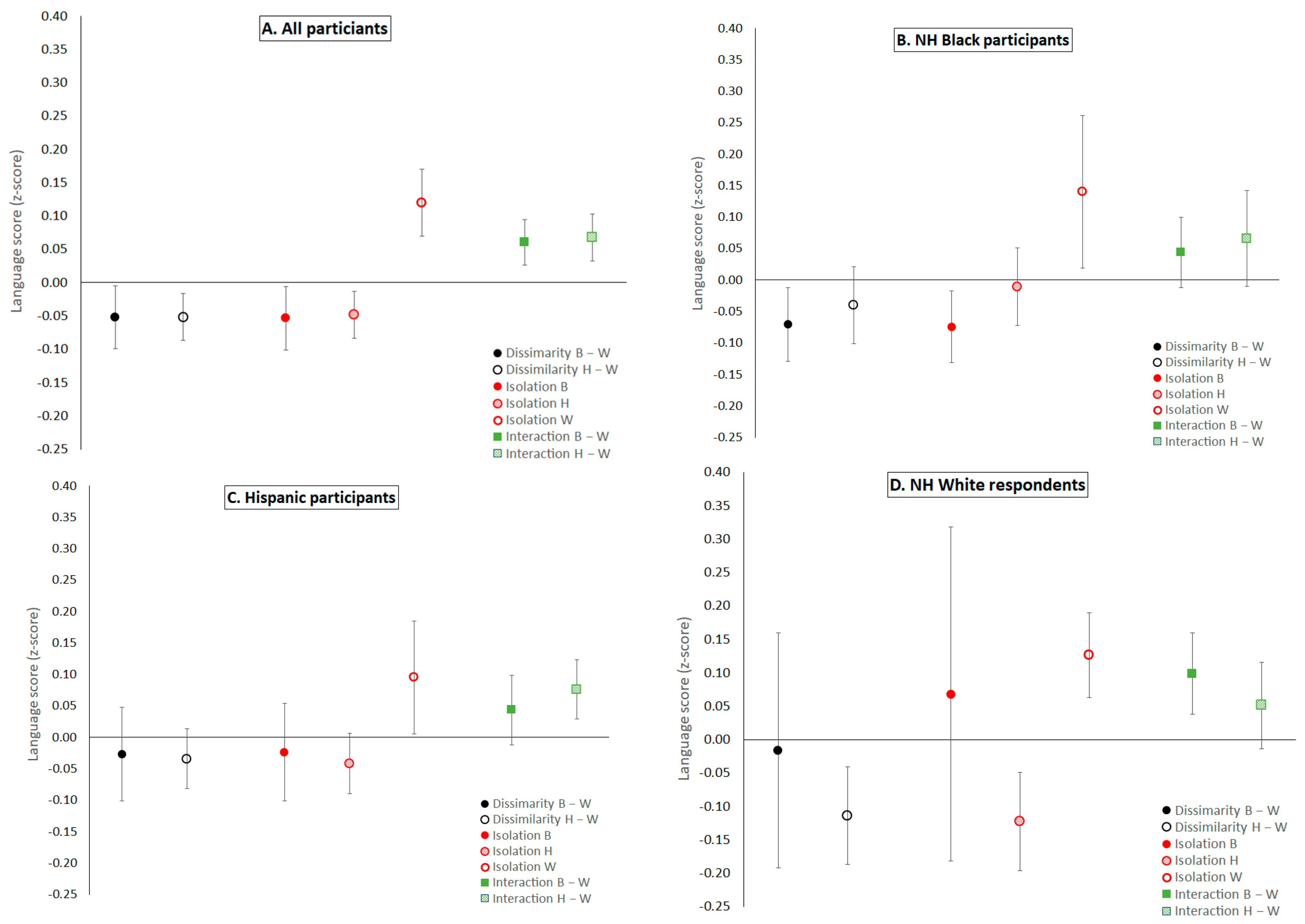Relationship between Residential Segregation, Later-Life Cognition, and Incident Dementia across Race/Ethnicity
Abstract
:1. Introduction
2. Materials and Methods
2.1. Source Population and Analytic Sample
2.2. Effect Modifier: Race/Ethnicity
2.3. Exposure of Interest: Racial Residential Segregation from 2005–2009
2.4. Outcomes: Cognitive Performance and Incident Dementia
2.5. Other Variables
2.6. Statistical Analysis
3. Results
3.1. Descriptive Statistics
3.2. Block-Group Segregation and Level of Later Life Cognitive Abilities
3.3. Incident Dementia
4. Discussion
5. Conclusions
Supplementary Materials
Author Contributions
Funding
Institutional Review Board Statement
Informed Consent Statement
Data Availability Statement
Acknowledgments
Conflicts of Interest
References
- Krieger, N. Theories for social epidemiology in the 21st century: An ecosocial perspective. Int. J. Epidemiol. 2001, 30, 668–677. [Google Scholar] [CrossRef]
- Williams, D.R.; Collins, C. Racial residential segregation: A fundamental cause of racial disparities in health. Public Health Rep. 2001, 116, 404–416. [Google Scholar] [CrossRef]
- Helzner, E.P.; Cauley, J.A.; Pratt, S.R.; Wisniewski, S.; Zmuda, J.M.; Talbott, E.; De Rekeneire, N.; Ms, T.B.H.; Rubin, S.M.; Simonsick, E.M.; et al. Race and Sex Differences in Age-Related Hearing Loss: The Health, Aging and Body Composition Study. J. Am. Geriatr. Soc. 2005, 53, 2119–2127. [Google Scholar] [CrossRef]
- Scarmeas, N.; Stern, Y. Cognitive Reserve and Lifestyle. J. Clin. Exp. Neuropsychol. 2003, 25, 625–633. [Google Scholar] [CrossRef] [PubMed]
- Grady, S.C. Racial disparities in low birthweight and the contribution of residential segregation: A multilevel analysis. Soc. Sci. Med. 2006, 63, 3013–3029. [Google Scholar] [CrossRef]
- Kramer, M.R.; Hogue, C.R. Place Matters: Variation in the Black/White Very Preterm Birth Rate across U.S. Metropolitan Areas, 2002–2004. Public Health Rep. 2008, 123, 576–585. [Google Scholar] [CrossRef]
- Bravo, M.A.; Anthopolos, R.; Kimbro, R.T.; Miranda, M.L. Residential Racial Isolation and Spatial Patterning of Type 2 Diabetes Mellitus in Durham, North Carolina. Am. J. Epidemiol. 2018, 187, 1467–1476. [Google Scholar] [CrossRef] [PubMed]
- Kershaw, K.N.; Robinson, W.; Gordon-Larsen, P.; Hicken, M.T.; Goff, D.C.; Carnethon, M.; Kiefe, C.I.; Sidney, S.; Roux, A.V.D. Association of Changes in Neighborhood-Level Racial Residential Segregation With Changes in Blood Pressure Among Black Adults. JAMA Intern. Med. 2017, 177, 996–1002. [Google Scholar] [CrossRef]
- Collins, C.A. Racism and health: Segregation and causes of death amenable to medical intervention in major U.S. cities. Ann. N. Y. Acad. Sci. 1999, 896, 396–398. [Google Scholar] [CrossRef] [PubMed]
- Landrine, H.; Corral, I. Separate and unequal: Residential segregation and black health disparities. Ethn. Dis. 2009, 19, 179. [Google Scholar]
- Barnes, L.L.; Bennett, D.A. Alzheimer’s Disease In African Americans: Risk Factors And Challenges For The Future. Health Aff. 2014, 33, 580–586. [Google Scholar] [CrossRef]
- Morris, J.C.; Schindler, S.; McCue, L.M.; Moulder, K.L.; Benzinger, T.L.S.; Cruchaga, C.; Fagan, A.M.; Grant, E.; Gordon, B.; Holtzman, D.M.; et al. Assessment of Racial Disparities in Biomarkers for Alzheimer Disease. JAMA Neurol. 2019, 76, 264–273. [Google Scholar] [CrossRef] [PubMed]
- Szanton, S.L.; Rifkind, J.M.; Mohanty, J.G.; Miller, E.R.; Thorpe, R.J.; Nagababu, E.; Epel, E.S.; Zonderman, A.B.; Evans, M. Racial Discrimination Is Associated with a Measure of Red Blood Cell Oxidative Stress: A Potential Pathway for Racial Health Disparities. Int. J. Behav. Med. 2012, 19, 489–495. [Google Scholar] [CrossRef] [PubMed] [Green Version]
- Saxe, J.S. Promoting Healthy Lifestyles and Decreasing Childhood Obesity: Increasing Physician Effectiveness Through Advocacy. Ann. Fam. Med. 2011, 9, 546–548. [Google Scholar] [CrossRef] [PubMed]
- Kelli, H.M.; Hammadah, M.; Ahmed, H.; Ko, Y.-A.; Topel, M.; Samman-Tahhan, A.; Awad, M.; Patel, K.; Mohammed, K.; Sperling, L.S.; et al. Association Between Living in Food Deserts and Cardiovascular Risk. Circ. Cardiovasc. Qual. Outcomes 2017, 10. [Google Scholar] [CrossRef] [PubMed]
- Bailey, Z.D.; Feldman, J.M.; Bassett, M.T. How Structural Racism Works—Racist Policies as a Root Cause of U.S. Racial Health Inequities. N. Engl. J. Med. 2021, 384, 768–773. [Google Scholar] [CrossRef]
- Caunca, M.R.; Odden, M.C.; Glymour, M.M.; Elfassy, T.; Kershaw, K.N.; Sidney, S.; Yaffe, K.; Launer, L.; Al Hazzouri, A.Z. Association of Racial Residential Segregation Throughout Young Adulthood and Cognitive Performance in Middle-aged Participants in the CARDIA Study. JAMA Neurol. 2020, 77, 1000. [Google Scholar] [CrossRef] [PubMed]
- Meyer, O.L.; Sisco, S.M.; Harvey, D.; Zahodne, L.B.; Glymour, M.M.; Manly, J.J.; Marsiske, M. Neighborhood Predictors of Cognitive Training Outcomes and Trajectories in ACTIVE. Res. Aging 2017, 39, 443–467. [Google Scholar] [CrossRef]
- Sheffield, K.M.; Peek, M.K. Neighborhood Context and Cognitive Decline in Older Mexican Americans: Results From the Hispanic Established Populations for Epidemiologic Studies of the Elderly. Am. J. Epidemiol. 2009, 169, 1092–1101. [Google Scholar] [CrossRef] [Green Version]
- Espino, D.V.; Lichtenstein, M.J.; Palmer, R.F.; Hazuda, H.P. Ethnic Differences in Mini-Mental State Examination (MMSE) Scores: Where You Live Makes a Difference. J. Am. Geriatr. Soc. 2001, 49, 538–548. [Google Scholar] [CrossRef]
- Furman Center. Washington Heights/Inwood Neighborhood Profile. Available online: https://furmancenter.org/neighborhoods/view/washington-heights-inwood (accessed on 11 June 2021).
- Aneshensel, C.S.; Ko, M.J.; Chodosh, J.; Wight, R.G. The Urban Neighborhood and Cognitive Functioning in Late Middle Age. J. Health Soc. Behav. 2011, 52, 163–179. [Google Scholar] [CrossRef] [PubMed]
- Kovalchik, S.A.; Slaughter, M.E.; Miles, J.; Friedman, E.M.; Shih, R.A. Neighbourhood racial/ethnic composition and segregation and trajectories of cognitive decline among US older adults. J. Epidemiol. Commun. Health 2015, 69, 978–984. [Google Scholar] [CrossRef] [PubMed]
- Weden, M.M.; Miles, J.N.V.; Friedman, E.; Escarce, J.J.; Peterson, C.; Langa, K.M.; Shih, R.A. The Hispanic Paradox: Race/Ethnicity and Nativity, Immigrant Enclave Residence and Cognitive Impairment Among Older US Adults. J. Am. Geriatr. Soc. 2017, 65, 1085–1091. [Google Scholar] [CrossRef] [PubMed] [Green Version]
- Garcia, M.A.; Reyes, A.M.; García, C.; Chiu, C.-T.; Macias, G. Nativity and Country of Origin Variations in Life Expectancy With Functional Limitations Among Older Hispanics in the United States. Res. Aging 2020, 42, 199–207. [Google Scholar] [CrossRef] [PubMed]
- Massey, D.S.; Denton, N.A. The Dimensions of Residential Segregation. Soc. Forces 1988, 67, 281. [Google Scholar] [CrossRef]
- Yang, T.; Park, K.; Matthews, S.A. Racial/ethnic segregation and health disparities: Future directions and opportunities. Sociol. Compass 2020, 14, e12749. [Google Scholar] [CrossRef]
- Manly, J.J.; Byrd, D.; Touradji, P.; Sanchez, D.; Stern, Y. Literacy and cognitive change among ethnically diverse elders. Int. J. Psychol. 2004, 39, 47–60. [Google Scholar] [CrossRef]
- Duncan, O.D.; Duncan, B. A Methodological Analysis of Segregation Indexes. Am. Sociol. Rev. 1955, 20, 210–217. [Google Scholar] [CrossRef]
- Reardon, S.F.; O’Sullivan, D. Measures of Spatial Segregation. Sociol. Methodol. 2004, 34, 121–162. [Google Scholar] [CrossRef]
- White, M.J. Segregation and Diversity Measures in Population Distribution. Popul. Index 1986, 52, 198–221. [Google Scholar] [CrossRef]
- Weiss, L.; Ompad, D.; Galea, S.; Vlahov, D. Defining Neighborhood Boundaries for Urban Health Research. Am. J. Prev. Med. 2007, 32, S154–S159. [Google Scholar] [CrossRef]
- Siedlecki, K.L.; Manly, J.J.; Brickman, A.M.; Schupf, N.; Tang, M.-X.; Stern, Y. Do neuropsychological tests have the same meaning in Spanish speakers as they do in English speakers? Neuropsychology 2010, 24, 402–411. [Google Scholar] [CrossRef] [Green Version]
- Avila, J.F.; Rentería, M.A.; Witkiewitz, K.; Verney, S.P.; Vonk, J.M.J.; Manly, J.J. Measurement invariance of neuropsychological measures of cognitive aging across race/ethnicity by sex/gender groups. Neuropsychology 2020, 34, 3. [Google Scholar] [CrossRef]
- Buschke, H.; Fuld, P.A. Evaluating storage, retention, and retrieval in disordered memory and learning. Neurology 1974, 24, 1019–1025. [Google Scholar] [CrossRef] [PubMed] [Green Version]
- Benton, A.L. Visual Retention Test Forms C, D, E.; University of Iowa: Iowa, IA, USA, 1955; Available online: https://catalog.hathitrust.org/Record/100896554 (accessed on 28 December 2020).
- Rosen, W. The Rosen Drawing Test; Veterans Administration Medical Center: Bronx, NY, USA, 1981. [Google Scholar]
- Mattis, S. Mental status examination for organic mental syndrome in the elderly patients. In Geriatric Psychiatry; Grune & Stratton: New York, NY, USA, 1976; pp. 77–121. [Google Scholar]
- Jacobs, D.; Sano, M.; Albert, S.; Schofield, P.; Dooneief, G.; Stern, Y. Cross-cultural neuropsychological assessment: A comparison of randomly selected, demographically matched cohorts of English-and Spanish-speaking older adults. J. Clin. Exp. Neuropsychol. 1997, 19, 331–339. [Google Scholar] [CrossRef] [PubMed]
- Manly, J.J.; Bell-McGinty, S.; Tang, M.-X.; Schupf, N.; Stern, Y.; Mayeux, R. Implementing Diagnostic Criteria and Estimating Frequency of Mild Cognitive Impairment in an Urban Community. Arch. Neurol. 2005, 62, 1739–1746. [Google Scholar] [CrossRef]
- McKhann, G.M.; Knopman, D.S.; Chertkow, H.; Hyman, B.T.; Jack, C.R.; Kawas, C.H.; Klunk, W.E.; Koroshetz, W.J.; Manly, J.J.; Mayeux, R.; et al. The diagnosis of dementia due to Alzheimer’s disease: Recommendations from the National Institute on Aging-Alzheimer’s association workgroups on diagnostic guidelines for Alzheimer’s disease. Alzheimers Dement. 2011, 7, 263–269. [Google Scholar] [CrossRef] [Green Version]
- McKeith, I.; Perry, E.; Perry, R. Report of the second dementia with Lewy body international workshop: Diagnosis and treatment. Neurology 1999, 53, 902–905. [Google Scholar] [CrossRef]
- Roman, G.C.; Tatemichi, T.K.; Erkinjuntti, T.; Cummings, J.L.; Masdeu, J.C.; Garcia, J.H.; Amaducci, L.; Orgogozo, J.-M.; Brun, A.; Hofman, A.; et al. Vascular dementia: Diagnostic criteria for research studies: Report of the NINDS-AIREN International Workshop. Neurology 1993, 43, 250. [Google Scholar] [CrossRef]
- Stern, Y.; Andrews, H.; Pittman, J.; Sano, M.; Tatemichi, T.; Lantigua, R.; Mayeux, R. Diagnosis of dementia in a heterogeneous population: Development of a neuropsychological paradigm-based diagnosis of dementia and quantified correction for the effects of education. Arch. Neurol. 1992, 49, 453–460. [Google Scholar] [CrossRef]
- Gardener, H.; Wright, C.; Rundek, T.; Sacco, R.L. Brain health and shared risk factors for dementia and stroke. Nat. Rev. Neurol. 2015, 11, 651–657. [Google Scholar] [CrossRef] [PubMed]
- McClelland, G.H.; Judd, C.M. Statistical difficulties of detecting interactions and moderator effects. Psychol. Bull. 1993, 114, 376. [Google Scholar] [CrossRef] [PubMed]
- Austin, P.C. A Tutorial on Multilevel Survival Analysis: Methods, Models and Applications. Int. Stat. Rev. 2017, 85, 185–203. [Google Scholar] [CrossRef]
- Davis, R.; Resnick, S. Limit theory for the sample covariance and correlation functions of moving averages. Ann. Stat. 1986, 14, 533–558. [Google Scholar] [CrossRef]
- Hunt, J.F.V.; Buckingham, W.; Kim, A.J.; Oh, J.; Vogt, N.M.; Jonaitis, E.M.; Hunt, T.K.; Zuelsdorff, M.; Powell, W.R.; Norton, D.; et al. Association of Neighborhood-Level Disadvantage With Cerebral and Hippocampal Volume. JAMA Neurol. 2020, 77, 451–460. [Google Scholar] [CrossRef]
- Levy, D.E.; Pachucki, M.C.; O’Malley, A.J.; Porneala, B.; Yaqubi, A.; Thorndike, A.N. Social connections and the healthfulness of food choices in an employee population. Nat. Hum. Behav. 2021, 5, 1–9. [Google Scholar] [CrossRef] [PubMed]
- Clark, R.; Anderson, N.B.; Clark, V.R.; Williams, D.R. Racism as a stressor for African Americans: A biopsychosocial model. Am. Psychol. 1999, 54, 805. [Google Scholar] [CrossRef]
- Paradies, Y.; Ben, J.; Denson, N.; Elias, A.; Priest, N.; Pieterse, A.; Gupta, A.; Kelaher, M.; Gee, G. Racism as a Determinant of Health: A Systematic Review and Meta-Analysis. PLoS ONE 2015, 10, e0138511. [Google Scholar] [CrossRef] [Green Version]
- Robert, S.A.; Ruel, E. Racial segregation and health disparities between Black and White older adults. J. Gerontol. Ser. B 2006, 61, S203–S211. [Google Scholar] [CrossRef] [PubMed] [Green Version]
- Glymour, M.M.; Manly, J.J. Lifecourse Social Conditions and Racial and Ethnic Patterns of Cognitive Aging. Neuropsychol. Rev. 2008, 18, 223–254. [Google Scholar] [CrossRef]
- Yaffe, K.; Falvey, C.; Harris, T.B.; Newman, A.B.; Satterfield, S.; Koster, A.; Ayonayon, H.; Simonsick, E. Effect of socioeconomic disparities on incidence of dementia among biracial older adults: Prospective study. BMJ 2013, 347, f7051. [Google Scholar] [CrossRef] [PubMed] [Green Version]
- Besser, L.M.; McDonald, N.C.; Song, Y.; Kukull, W.A.; Rodriguez, D.A. Neighborhood Environment and Cognition in Older Adults: A Systematic Review. Am. J. Prev. Med. 2017, 53, 241–251. [Google Scholar] [CrossRef] [Green Version]
- Kim, D.; Griffin, B.A.; Kabeto, M.; Escarce, J.; Langa, K.M.; Shih, R.A. Lagged Associations of Metropolitan Statistical Area- and State-Level Income Inequality with Cognitive Function: The Health and Retirement Study. PLoS ONE 2016, 11, e0157327. [Google Scholar] [CrossRef]
- Zeki Al Hazzouri, A.; Haan, M.N.; Osypuk, T.; Abdou, C.; Hinton, L.; Aiello, A.E. Neighborhood socioeconomic context and cognitive decline among older Mexican Americans: Results from the Sacramento Area Latino Study on Aging. Am. J. Epidemiol. 2011, 174, 423–431. [Google Scholar] [CrossRef] [Green Version]
- Aneshensel, C.S.; Sucoff, C.A. The neighborhood context of adolescent mental health. J. Health Soc. Behav. 1996, 37, 293–310. [Google Scholar] [CrossRef]
- Versey, H.S. A tale of two Harlems: Gentrification, social capital, and implications for aging in place. Soc. Sci. Med. 2018, 214, 1–11. [Google Scholar] [CrossRef] [PubMed]
- Wheaton, B.; Clarke, P. Space meets time: Integrating temporal and contextual influences on mental health in early adulthood. Am. Sociol. Rev. 2003, 68, 680–706. [Google Scholar] [CrossRef]
- Hernandez, R.; Sezgin, U.; Marrara, S. When a Neighborhood Becomes a Revolving Door for Dominicans: Rising Housing Costs in Washington Heights/Inwood and the Declining Presence of Dominicans. 2018. Available online: https://academicworks.cuny.edu/cgi/viewcontent.cgi?article=1025&context=dsi_pubs (accessed on 15 June 2021).
- Speedie, L.; Rabins, P.; Pearlson, G.; Moberg, P. Confrontation naming deficit in dementia of depression. J. Neuropsychiatry Clin. Neurosci. 1990, 2, 59–63. [Google Scholar] [CrossRef] [PubMed]
- Crocco, E.A.; Castro, K.; Loewenstein, D.A. How Late-Life Depression Affects Cognition: Neural Mechanisms. Curr. Psychiatry Rep. 2010, 12, 34–38. [Google Scholar] [CrossRef]
- Wong, W. Economic burden of Alzheimer disease and managed care considerations. Am. J. Manag. Care 2020, 26 (Suppl. 8), S177–S183. [Google Scholar]




| Racial Residential Segregation 1 | ||
|---|---|---|
| Characteristic | Segregated n = 2603 (56.4%) | Not Segregated n = 2013 (43.6%) |
| Age, mean (SD), (y) | 75.91 (6.44) | 75.52 (6.47) |
| Educational level, mean (SD), (y) | 9.21 (4.80) | 11.42 (4.98) |
| Women, No. (%) | 1804 (69.30) | 1310 (65.08) |
| Race/ethnicity, No. (%) | ||
| Hispanic/Latino | 1322 (50.79) | 742 (36.86) |
| Non-Hispanic Black | 938 (36.04) | 468 (23.25) |
| Non-Hispanic White | 343 (13.18) | 803 (39.89) |
| Tested in English, No. (%) | 1348 (51.79) | 1337 (66.42) |
| CSES, mean (SD) | −0.091 (0.644) | 0.083 (0.653) |
| Occupation, No. (%) | ||
| Low | 1511 (58.05) | 823 (40.88) |
| Middle | 543 (20.86) | 454 (22.55) |
| High | 424 (16.29) | 648 (32.19) |
| Not reported | 125 (4.80) | 88 (4.37) |
| Birthplace, No. (%) | ||
| USA | 910 (34.96) | 810 (40.24) |
| Puerto Rico | 119 (4.57) | 70 (3.48) |
| Dominican Republic | 794 (30.50) | 347 (17.24) |
| Not reported | 780 (29.97) | 786 (39.05) |
| Cohort, No. (%) | ||
| 1992 | 679 (26.09) | 505 (25.09) |
| 1998 | 964 (37.03) | 717 (35.62) |
| 2009 | 960 (36.88) | 791 (39.29) |
| Area poverty level, mean (SD) | 0.267 (0.118) | 0.212 (0.130) |
| CVD count, mean (SD) | 1.240 (0.932) | 1.088 (0.927) |
| Cognitive scores 2, mean (SD) | ||
| Memory | 0.009 (0.821) | 0.245 (0.850) |
| Language | −0.033 (0.700) | 0.299 (0.769) |
| Visuospatial abilities | 0.054 (0.687) | 0.327 (0.657) |
| Incident dementia 2, No. (%) | 412 (18.9) | 325 (13.7%) |
| Residential Segregation Indices 1 | Memory 2 β (95% CI) | Language 2 β (95% CI) | Visuospatial 2 β (95% CI) | Incident Dementia 3 HR (95% CI) |
|---|---|---|---|---|
| Dissimilarity NH Black-NH White | −0.054 (−0.108; –0.001) | −0.052 (−0.099; –0.005) | −0.037 (−0.085; 0.011) | 1.14 (0.92; 1.41) |
| Dissimilarity Hispanic-NH White | 0.027 (−0.014; 0.067) | −0.051 (−0.087; −0.016) | −0.043 (−0.079; –0.007) | 0.96 (0.82; 1.13) |
| Isolation NH Black | −0.049 (−0.104; 0.007) | −0.053 (−0.101; −0.006) | −0.043 (−0.093; 0.006) | 1.16 (0.94; 1.44) |
| Isolation Hispanic | 0.013 (−0.029; 0.055) | −0.048 (−0.084; −0.013) | −0.054 (−0.090; –0.019) | 1.07 (0.91; 1.26) |
| Isolation NH White | 0.004 (−0.056; 0.065) | 0.120 (0.070; 0.170) | 0.040 (−0.010; 0.091) | 0.86 (0.62; 1.19) |
| Interaction NH Black-NH White | 0.015 (−0.027; 0.058) | 0.061 (0.026; 0.095) | 0.012 (−0.026; 0.050) | 0.94 (0.78; 1.14) |
| Interaction Hispanic-NH White | 0.062 (0.020; 0.105) | 0.067 (0.032; 0.103) | 0.050 (0.014; 0.087) | 0.94 (0.79; 1.12) |
| Residential Segregation 1 Indices | Memory 2 | Language 2 | Visuospatial 2 | Incident Dementia 3 |
|---|---|---|---|---|
| β (95% CI) | β (95% CI) | β (95% CI) | HR (95% CI) | |
| NH Black respondents | ||||
| Dissimilarity NH Black—NH White | −0.073 (−0.143; −0.003) | −0.071 (−0.129; −0.012) | −0.008 (−0.067; 0.051) | 1.74 (1.34; 2.27) |
| Dissimilarity Hispanic-NH White | 0.032 (−0.039; 0.103) | −0.040 (−0.101; 0.021) | −0.042 (−0.103; 0.018) | 1.05 (0.78; 1.41) |
| Isolation NH Black | −0.053 (−0.121; 0.015) | −0.074 (−0.132; −0.017) | −0.017 (−0.075; 0.042) | 1.72 (1.32; 2.24) |
| Isolation Hispanic | 0.032 (−0.040; 0.104) | −0.010 (−0.072; 0.052) | −0.040 (−0.100; 0.020) | 1.27 (0.95; 1.69) |
| Isolation NH White 4 | 0.093 (−0.069; 0.255) | 0.140 (0.019; 0.262) | 0.093 (−0.033; 0.219) | 1.01 (0.32; 3.19) |
| Interaction NH Black—NH White | 0.028 (−0.042; 0.098) | 0.044 (−0.012; 0.100) | 0.045 (−0.014; 0.104) | 1.21 (0.91; 1.61) |
| Interaction Hispanic—NH White | 0.087 (−0.007; 0.180) | 0.066 (−0.010; 0.142) | 0.004 (−0.072; 0.080) | 0.82 (0.50; 1.34) |
| Hispanic respondents | ||||
| Dissimilarity NH Black-NH White | −0.015 (−0.107; 0.077) | −0.027 (−0.101; 0.048) | −0.066 (−0.142; 0.010) | 1.05 (0.76; 1.44) |
| Dissimilarity Hispanic-NH White | 0.020 (−0.038; 0.078) | −0.034 (−0.082; 0.014) | −0.050 (−0.098; –0.002) | 1.05 (0.86; 1.28) |
| Isolation NH Black | −0.029 (−0.125; 0.067) | −0.024 (−0.101; 0.054) | −0.086 (−0.166; –0.007) | 1.05 (0.76; 1.46) |
| Isolation Hispanic | −0.009 (−0.068; 0.050) | −0.041 (−0.089; 0.007) | −0.079 (−0.126; –0.031) | 1.13 (0.93; 1.39) |
| Isolation NH White | 0.048 (−0.065; 0.162) | 0.095 (0.006; 0.185) | 0.071 (−0.020; 0.162) | 0.87 (0.54; 1.38) |
| Interaction NH Black-NH White | 0.030 (−0.040; 0.101) | 0.043 (−0.012; 0.099) | 0.030 (−0.029; 0.089) | 1.04 (0.81; 1.33) |
| Interaction Hispanic—NH White | 0.060 (0.002; 0.119) | 0.076 (0.029; 0.123) | 0.080 (0.031; 0.128) | 0.95 (0.78; 1.17) |
| NH White respondents | ||||
| Dissimilarity NH Black-NH White 4 | –0.096 (–0.308; 0.115) | −0.016 (−0.192; 0.159) | −0.164 (−0.330; 0.002) | 0.98 (0.24; 3.98) |
| Dissimilarity Hispanic-NH White | 0.034 (–0.054; 0.121) | −0.114 (−0.187; –0.041) | −0.028 (−0.099; 0.044) | 0.53 (0.34; 0.84) |
| Isolation NH Black 4 | –0.185 (–0.507; 0.137) | 0.068 (−0.182; 0.318) | −0.166 (−0.414; 0.083) | N/A |
| Isolation Hispanic | 0.036 (–0.053; 0.124) | −0.122 (−0.196; –0.049) | −0.018 (−0.089; 0.053) | 0.60 (0.38; 0.94) |
| Isolation NH White | –0.038 (–0.114; 0.038) | 0.126 (0.063; 0.190) | 0.013 (−0.050; 0.076) | 0.52 (0.35; 0.78) |
| Interaction NH Black-NH White | –0.017 (–0.094; 0.059) | 0.099 (0.038; 0.159) | −0.044 (−0.107; 0.019) | 0.50 (0.31; 0.83) |
| Interaction Hispanic-NH White | 0.049 (–0.031; 0.128) | 0.051 (−0.013; 0.116) | 0.029 (−0.036; 0.094) | 0.58 (0.42; 0.80) |
Publisher’s Note: MDPI stays neutral with regard to jurisdictional claims in published maps and institutional affiliations. |
© 2021 by the authors. Licensee MDPI, Basel, Switzerland. This article is an open access article distributed under the terms and conditions of the Creative Commons Attribution (CC BY) license (https://creativecommons.org/licenses/by/4.0/).
Share and Cite
Pohl, D.J.; Seblova, D.; Avila, J.F.; Dorsman, K.A.; Kulick, E.R.; Casey, J.A.; Manly, J. Relationship between Residential Segregation, Later-Life Cognition, and Incident Dementia across Race/Ethnicity. Int. J. Environ. Res. Public Health 2021, 18, 11233. https://doi.org/10.3390/ijerph182111233
Pohl DJ, Seblova D, Avila JF, Dorsman KA, Kulick ER, Casey JA, Manly J. Relationship between Residential Segregation, Later-Life Cognition, and Incident Dementia across Race/Ethnicity. International Journal of Environmental Research and Public Health. 2021; 18(21):11233. https://doi.org/10.3390/ijerph182111233
Chicago/Turabian StylePohl, Daniel J., Dominika Seblova, Justina F. Avila, Karen A. Dorsman, Erin R. Kulick, Joan A. Casey, and Jennifer Manly. 2021. "Relationship between Residential Segregation, Later-Life Cognition, and Incident Dementia across Race/Ethnicity" International Journal of Environmental Research and Public Health 18, no. 21: 11233. https://doi.org/10.3390/ijerph182111233
APA StylePohl, D. J., Seblova, D., Avila, J. F., Dorsman, K. A., Kulick, E. R., Casey, J. A., & Manly, J. (2021). Relationship between Residential Segregation, Later-Life Cognition, and Incident Dementia across Race/Ethnicity. International Journal of Environmental Research and Public Health, 18(21), 11233. https://doi.org/10.3390/ijerph182111233






